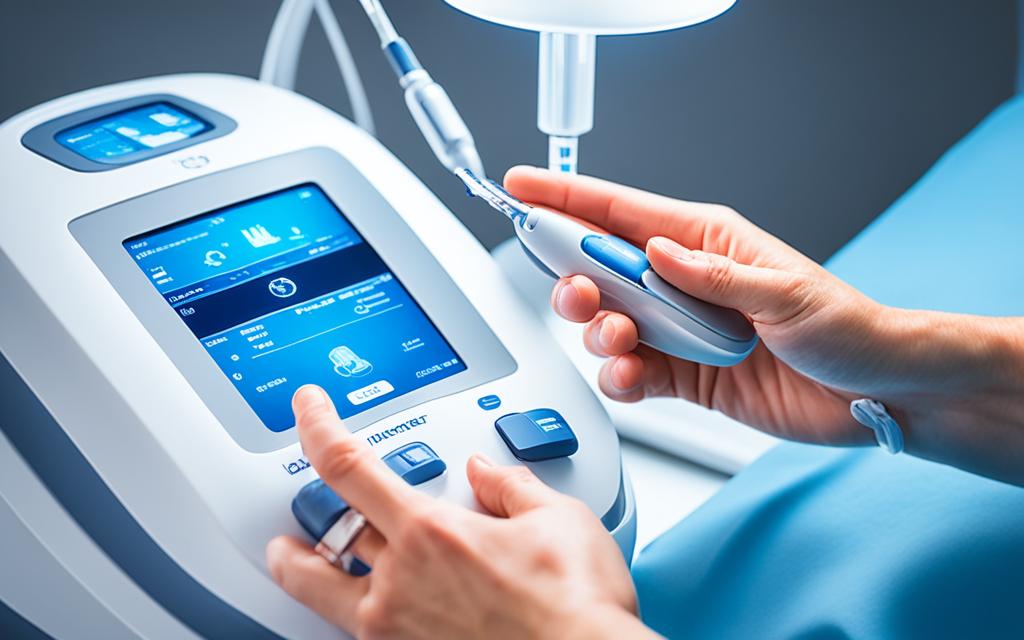Effective Therapy for Trigger Finger Relief
If you’re struggling with trigger finger, you’re not the only one. This condition causes pain, stiffness, and a feeling of your finger getting stuck. It can really impact your day to day life. But, there is hope because treatments for trigger finger can really help. In this article, we will look at different trigger finger treatment options. These range from simple, non-surgical methods to surgery. We aim to give you the details you need to make a smart choice about your health. Finding the right treatment can bring you trigger finger relief and make your finger move smoothly again, just like many others want.
Key Takeaways
- Understanding trigger finger and its impact on daily activities.
- Various non-surgical therapy for trigger finger options available.
- Significance of early intervention in trigger finger treatment.
- The potential need for surgical treatments and when to consider them.
- Home remedies and exercises that contribute to trigger finger relief.
- Physical therapy’s role in improving finger mobility and reducing pain.
Understanding Trigger Finger and Its Symptoms
Trigger finger affects your fingers or thumb. It causes pain, stiffness, and trouble in moving the digit. The condition comes from inflammation that narrows the tendon’s space. If your finger feels stiff in the morning, hurts when moving, or pops, you might have trigger finger.
A key sign of trigger finger symptoms is a clicking or locking feeling when you move your finger. This can make it hard to do everyday tasks like hold things or type. Spotting these signs early is important to tackle the issue before it gets worse.
The physical pain of trigger finger symptoms can upset your daily life. Symptoms can vary, making it different for everyone. That’s why knowing the trigger finger causes is key for managing and treating it.
- Morning stiffness or locking of the finger
- Painful clicking when moving the finger
- Difficulty in straightening the finger fully
- Pain and tenderness at the base of the finger
Understanding these signs is crucial for a right diagnosis and treatment. Catching trigger finger causes early can ease symptoms and improve finger movement. Being aware and seeking help early matters a lot.
Identifying Common Causes of Trigger Finger
Knowing what causes trigger finger is key to dealing with it. Repetitive motion and occupational hazards play a big part. We’ll look at how these can lead to trigger finger and ways to lessen the risk.
Repetitive Motion and Occupational Hazards
Repetitive motion often leads to trigger finger. Doing things over and over, like gripping or bending fingers, ups the risk. Jobs like musician, factory worker, or office jobs with lots of computer use pose risks. With these, it’s both the repeat actions and how long your hands are used that matter.
Health Conditions Linked to Trigger Finger
Some health issues can also raise the risk of trigger finger. People with diabetes or rheumatoid arthritis are more likely to get it. The swelling and changes in tissue from these conditions make it hard for fingers to move smoothly.
| Condition | How It Contributes to Trigger Finger |
|---|---|
| Diabetes | High glucose levels may lead to glycosylation of proteins in the tendon, causing stiffness and resistance. |
| Rheumatoid Arthritis | Chronic inflammation can cause significant swelling around the joints and tendons, restricting movement. |
Therapy for Trigger Finger: Non-Surgical Options
Looking into therapy for trigger finger without surgery is a smart choice for many people. You will find various treatments that help ease the pain and make movement easier without surgery.
- Splinting: A splint keeps your finger straight, especially helpful at night. This prevents your finger from bending and being painful in the morning.
- Steroid Injections: These injections help lessen inflammation. Doctors inject medicine right into the affected area to reduce swelling and pain.
- Trigger finger exercises: Certain exercises can make your finger tendons and muscles stronger and more flexible. Practices like lifting, stretching, and bending your finger help keep it moving smoothly and lessen stiffness.
- Heat and cold therapy: Applying heat or cold can lessen swelling and give temporary pain relief. This can make you feel better for a little while.
Using these trigger finger treatment techniques regularly can lead to major improvements. They help manage pain and make your finger move better, keeping you out of surgery.
| Treatment Type | Benefits | Considerations |
|---|---|---|
| Splinting | Holds finger straight, reduces discomfort | May be cumbersome during day activities |
| Steroid Injections | Quickly reduces inflammation | Potential for diminishing returns with repeated use |
| Physical Exercises | Increases mobility, reduces stiffness | Requires consistency for best results |
| Heat/Cold Therapy | Immediate symptom relief | Only provides temporary relief |
Considering these non-surgical trigger finger treatments carefully can help manage your condition. Each method has its perks. Sometimes, combining them based on your specific situation works best. Always talk to a healthcare provider to get a treatment plan that’s right for you.
When to Consider Trigger Finger Surgery
If you’ve been struggling with trigger finger and haven’t seen results from non-surgical methods, think about surgery. Trigger finger surgery, or trigger finger release, is often the next step if other treatments don’t work. It’s important to know when it’s the right time for surgery and to understand its benefits and downsides.
Assessing the Severity of Your Condition
Severe cases of trigger finger can be really painful and make your finger or thumb stiff. If it hurts a lot and messes with your daily life or sleep, you might need surgery. If your finger gets stuck bent and you have to pull it straight, surgery could help.
Exploring Surgical Interventions: Pros and Cons
Trigger finger surgery is meant to fix the part of your finger making it lock. Here’s what you should know about the good and bad sides:
- Benefits:
- High chance of feeling better
- Recover quickly
- Barely leaves a mark
- Risks:
- Possible infection at the cut
- Very rarely, it can harm nerves
- There’s a chance symptoms could come back
Talk with your doctor to really understand if surgery is right for you. They can help you weigh the good against the possible risks.
Home Remedies for Trigger Finger Relief
Managing trigger finger discomfort doesn’t always mean seeing a doctor. You can find relief with home remedies. They are easy and effective. They either help your main treatment or offer temporary relief.
- Warm Compresses: Applying warmth to the affected finger can significantly reduce stiffness and pain, enhancing flexibility.
- Gentle Stretching Exercises: Stretching the finger gently can help maintain mobility and prevent further stiffening of the tendons.
- Over-the-Counter Pain Relievers: Medications such as ibuprofen or naproxen can relieve inflammation and pain.
Combining these remedies daily can greatly help. But remember, being consistent is important for improvement.
Creating a Daily Routine: Adding these remedies to your daily life helps manage symptoms. It could even slow trigger finger’s progress. Start with the routine below:
| Time | Activity | Duration |
|---|---|---|
| Morning | Apply warm compress | 10 minutes |
| Midday | Gentle stretching | 5 minutes |
| Evening | Take over-the-counter pain reliever if necessary | As per medication guidelines |
Following this simple routine can make a big difference in your comfort and hand use. While these tips are useful, they can’t replace professional medical advice. If symptoms stay, get worse, or affect your day-to-day life, it’s important to see a doctor. They can create a specific treatment plan for you.
The Role of Physical Therapy in Treating Trigger Finger
For those dealing with trigger finger, physical therapy is a key supporter in getting mobility back and reducing pain. It combines special trigger finger exercises with therapy to craft a plan that fits each person’s needs.
Customized Therapy Programs
Your physical therapist will make a unique program to relieve the stiffness and pain of trigger finger. This plan not only helps with current symptoms but also prevents more issues.
Techniques Used by Physical Therapists
Physical therapists use both hands-on methods like massage and specific stretching, plus trigger finger exercises. These exercises aim to make the tendons in the fingers stronger, making them more flexible and movable.
| Technique | Description | Benefits |
|---|---|---|
| Manual Therapy | Gentle manipulation and movement of the finger | Reduces stiffness, increases mobility |
| Therapeutic Exercises | Specific movements targeting the affected finger | Strengthens tendons, improves flexibility |
| Heat Treatment | Application of heat to ease pain | Improves blood flow, relaxes muscles |
By including physical therapy in your treatment strategy, you quicken healing. This ensures your hand works better, making returning to everyday tasks easier and more comfortable.
Effective Trigger Finger Exercises to Try at Home
If you’re looking for ways to treat trigger finger at home, certain exercises can help. They boost flexibility, strength, and reduce stiffness. Here are some useful exercises that can ease pain and make your fingers more flexible:
- Finger Lifts: Place your hand flat on a table, palm down. Slowly raise each finger, hold for seconds, and lower it. Do this for all fingers, including the thumb.
- Thumb Flex and Extend: Start with an open hand. Move your thumb across to your pinky, then back. It stretches and strengthens thumb muscles.
- Make an O: Touch your thumb to each fingertip, forming an ‘O’. This boosts finger motion and flexibility.
- Finger Spread: Spread your fingers wide, hold, then relax. It helps relieve tension and improve control.
To get the most out of these exercises, remember:
- Do these exercises daily for the best results.
- Go slow and control your movements to avoid irritation.
- If they hurt, ease up on how often or how hard you do them.
Adding these simple exercises to your daily routine is important for trigger finger treatment. Keep at it to see improvements and to prevent trigger finger from coming back.
Keep track of how you’re doing with these exercises. If pain or swelling gets worse, see a doctor. Remember, these are to help with recovery, not to take the place of medical advice for serious conditions.
Exploring Alternative Treatments for Trigger Finger
Looking for relief from trigger finger? Consider alternative treatments. They can offer help beyond what standard methods provide. This part talks about how acupuncture and chiropractic care might improve your care plan. These benefits often go beyond what traditional treatments give.
Acupuncture and Trigger Finger
Acupuncture is a part of traditional Chinese medicine. It uses thin needles at specific body points. The goal is to kickstart the nervous system and boost blood flow. This can help lessen inflammation and pain from trigger finger. Many say they have less stiffness and better finger movement after acupuncture.
Chiropractic Care for Finger Mobility
Chiropractic care does more than just ease back and neck pain. It also offers help for trigger finger. Chiropractors work on the hand’s joints and soft tissues. They aim to boost motion range and lessen pain. Their work helps put joints back in place and eases finger tension.
| Treatment Type | Focus Area | Expected Benefits |
|---|---|---|
| Acupuncture | Pain and stiffness reduction | Improves circulation, reduces inflammation, enhances mobility |
| Chiropractic Care | Joint alignment and mobility | Decreases joint discomfort, improves functional movement of fingers |
Adding these alternative treatments to your routine may ease trigger finger pain and improve finger movement. Both acupuncture and chiropractic care bring new methods that support traditional medical treatments. They help bring back hand comfort and motion.
Understanding Trigger Finger Release Procedure
Exploring treatment for trigger finger means learning about the trigger finger release procedure. This surgery helps with the finger’s catching or locking. It’s caused by swollen tendons. We’ll explain what happens before, during, and after trigger finger surgery.
Your surgeon will review your health history and past treatments. This is to see if the surgery is right for you. Knowing the risks and benefits is key. It helps you have realistic expectations.
During trigger finger surgery, the doctor makes a small cut in your palm. They fix the tendon sheath that makes your finger stick. This is usually done in 20 to 30 minutes with local anesthesia.
Recovery time from trigger finger release varies for each person. But, it’s usually quick. Most patients get back to full function in a few weeks. Right after surgery, taking care of the area and starting movement exercises slowly is important.
| Before Surgery | During Surgery | After Surgery |
|---|---|---|
| Assessment and discussion of health history | Incision in palm | Pain management and exercise |
| Understanding of procedure and expectations | Release/widen the tendon sheath | Follow-up visits for progress tracking |
| Risks and benefits analysis | Procedure lasts 20-30 minutes | Regain function within a few weeks |
Thinking about trigger finger surgery? It’s vital to work closely with your healthcare provider. A good grasp of the trigger finger release procedure and following post-surgery advice helps with recovery.
Navigating the Recovery Process After Trigger Finger Surgery
After trigger finger surgery, the road to full recovery includes a well-planned rehab program. This program is key to getting your finger working right again. It also helps stop the problem from coming back. Let’s go over what recovery usually involves.
Post-Surgery Rehabilitation
The rehab after trigger finger surgery is vital for a quick and successful return to everyday life. Initially, rehab starts with simple exercises. These help increase movement and lessen stiffness. As you get better, you’ll do more to get strength back, taking care not to hurt the healing spot.
Some common rehab methods are:
- Gentle finger flexing and extending exercises
- Using splints or braces to help the finger heal
- Applying heat or cold to ease swelling and pain
Seeing your healthcare provider regularly after surgery is key. These visits let them keep track of your recovery. They can change your treatment if needed.
Long-Term Care and Prevention of Recurrence
Keep your fingers healthy after recovery to avoid trigger finger coming back. Continuing care is as important as the initial rehab.
Ways to prevent recurrence include:
- Doing stretches and strength exercises often
- Making your work and home spaces better for your hands
- Seeing a physical therapist now and then
Sticking to these guidelines ensures your surgery’s success. It also improves how well your hands work. This way, you can safely do more complex tasks without fear of problems.
Medications and Injections for Managing Trigger Finger Pain
If you’re looking into how to treat trigger finger, it’s key to know about the medicines out there. Medications for trigger finger and steroid injections help a lot. They work by easing inflammation and pain. This makes moving your finger easier.
Non-steroidal anti-inflammatory drugs (NSAIDs) are usually tried first. They tackle the pain and swelling of trigger finger. Drugs like ibuprofen and naproxen are common choices. They ease pain and cut down on swelling.
- Steroid Injections: For tougher cases, steroid injections work well. These shots lower swelling right at the trigger finger area.
- Frequency of Treatment: One shot can ease symptoms for months. Sometimes, a second shot is needed if the problem comes back.
- Potential Side Effects: Side effects are generally small but can happen. They include pain where you got the shot, skin color changes, and a short rise in blood sugar.
It’s vital to talk with your doctor about these treatments. They’ll help decide the best trigger finger treatment plan for you.
Lifestyle Adjustments to Prevent Trigger Finger
Making small changes in your daily routine can help stop trigger finger. Focus on workplace ergonomics and eating right. These steps can keep your fingers and joints healthy.
Workplace Ergonomics and Finger Health
Workspaces that are designed well boost your work and keep your fingers safe. Let’s look at ways to make your workspace better:
- Choose an ergonomic keyboard and mouse to minimize strain.
- Adjust your chair and desk to maintain proper posture with your shoulders relaxed and wrists supported.
- Take short breaks regularly to stretch your fingers and wrists, thus reducing the risk of stiffness and injury.
These tips keep your finger movement smooth and help avoid trigger finger.

Dietary Considerations and Nutritional Support
Eating the right foods is as important as having a good workspace for keeping your joints and fingers healthy. Some nutrients are key for healthy joints:
| Nutrient | Benefits | Sources |
|---|---|---|
| Omega-3 Fatty Acids | Reduce inflammation around the joints. | Fish, flaxseeds, walnuts |
| Calcium | Strengthens bones, preventing joint wear. | Dairy products, leafy greens, tofu |
| Vitamin D | Facilitates calcium absorption and bone growth. | Fatty fish, fortified foods, sunlight |
Adding these nutrients to your diet can make your joints and fingers stronger. This can help in avoiding trigger finger.
Conclusion
We’ve looked at many parts of understanding and treating trigger finger. It’s key to notice it early and find the right treatment. We’ve gone over symptoms, surgical and non-surgical ways to get better. This gives you a full view on how to ease the discomfort of trigger finger.
We also talked about how caring for yourself at home, doing physical therapy, and changing your lifestyle helps manage trigger finger. These steps make you feel better and stop trigger finger from coming back. By making changes like better office setup, eating well, and exercising, you can keep your fingers healthy.
Recovering from trigger finger might take time and effort. Knowing about the condition and treatment options helps you make smart choices for your health. It’s very important to get care that fits your needs. Talking to doctors helps you find the best way to take care of your hand. By taking control of your trigger finger treatment, you can keep your hands moving smoothly and without pain.
FAQ
What is trigger finger and how do I know if I have it?
Trigger finger makes a finger get stuck when bent. It then snaps straight, like pulling a trigger. You might have stiffness, a popping feeling when moving the finger, and tenderness in the palm. If these sound familiar, it’s good to see a doctor for diagnosis.
What causes trigger finger?
Often, trigger finger comes from repeated gripping actions. These actions can irritate the finger’s flexor tendons. The tendon sheath may narrow and inflame, causing trigger finger. Conditions like diabetes and rheumatoid arthritis also play a role.
Can trigger finger be treated without surgery?
Yes, several treatments don’t need surgery. These treatments reduce swelling and make room for the tendon to move. Options include splinting, exercises, medicine, and steroid shots. Many find these methods effectively ease symptoms.
When should I consider trigger finger surgery?
Surgery could be an option if other treatments haven’t helped much. Or if the condition badly affects hand use. Trigger finger release surgery is safe and often works well, providing long-term symptom relief.
What trigger finger exercises can I try at home?
Home exercises can help with trigger finger symptoms. Try lifting your fingers, touching your thumb, and gently bending and straightening the finger. Do these slowly and without causing pain to avoid more tendon irritation.
What alternative treatments are available for trigger finger?
Alongside standard treatments, acupuncture or chiropractic care may help. These methods can lessen the pain and make the finger move better. They often support other therapies well.
What does the trigger finger release procedure involve?
This procedure makes a tiny cut in the hand or uses a needle. The surgeon fixes the part of the tendon sheath blocking the tendon. The tendon then moves freely, stopping the catch or lock feeling of trigger finger.
How long does recovery take after trigger finger surgery?
Recovery can be quick, with many getting better within weeks. Doctors might suggest hand therapy or exercises to fasten recovery. These help get back mobility and strength in the finger.
Are there any medications that can help manage trigger finger pain?
Pain and swelling might be eased with over-the-counter drugs like ibuprofen. In some situations, a corticosteroid shot could greatly cut down inflammation and pain.
What lifestyle adjustments can I make to prevent trigger finger?
Try to make changes at work and in daily life to lessen finger strain. Add hand stretches, take breaks during repetitive work, and eat well for joint health. These can help keep trigger finger away.






